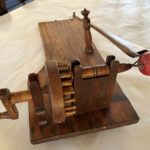From a lump of clay the potter made everything for pioneers
After the blacksmith, a potter was the next essential skilled tradesman in the burgeoning
towns of early Ohio Country in the 1800s.
Corn was staff of life for settlers, but was always labor intensive
After corn was husked, it had to be shelled and processed before it could be cooked into a meal in the early 1800s in Ohio Country.
Conestoga wagon was the Swiss Army knife of vehicles
The Conestoga wagon had many tools that helped families move westward in the 1800s. Paul Locher gives a detailed description of its most important features.
You couldn’t pioneer without a felling axe
Paul Locher continues his "An American Tale" series by introducing readers to the most important tool used to open the American frontier — the felling axe.
Early settlers’ decisions could mean life or death
After arriving and establishing a campsite, settlers had to deal with a trio of priorities immediately — clearing land, planting crops and building shelter.
Trees: The settlers’ biggest nemesis and asset
In his latest installment of "An American Tale," Paul Locher explains how early settlers managed to fell trees to build shelters in Ohio and Pennsylvania.
By hook or by crook, the wheat harvest was accomplished with intensive labor
Paul Locher details how 1800s pioneers in Ohio Country would have accomplished the wheat harvest and describes the tools they would have used to do it.
Corn husking bees brought neighbors together for work, socializing
Paul Locher details one of the great seasonal traditions among settlers in the Ohio Country — the husking bee or husking frolic.
Improving apple varieties was a major endeavor for settlers
Paul Locher explains how valuable apples were on the frontier of Ohio Country in the early 1800s, and how settlers improved varieties.
With apple butter parties, play preceded the work
Paul Locher offers a look inside the affairs of an apple butter party in Ohio Country in the early 1800s.
























